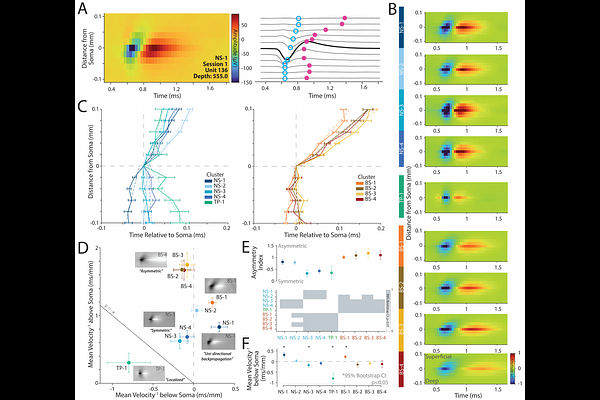High-resolution laminar recordings reveal structure-function relationships in monkey V1

High-resolution laminar recordings reveal structure-function relationships in monkey V1
Carr, N.; Zhu, S.; Lee, E. K.; Xia, R.; Chen, X.; Perliss, A.; Moore, T.; Chandrasekaran, C.
AbstractThe relationship between the structural properties of diverse neuronal populations in the monkey primary visual cortex (V1) and their functional visual processing in vivo remains a critical knowledge gap in visual neuroscience. We took advantage of high-density Neuropixels electrodes to record large populations of neurons across layers of macaque V1 and used a state-of-the-art non-linear dimensionality reduction approach on waveform shape to delineate nine putative cell classes, 4 narrow-spiking (NS), 4 broad-spiking (BS) and 1 tri-phasic (TP). Then, we performed targeted analyses of laminar organization, spike amplitude, multichannel spatial features, functional properties, and network connectivity of these cell classes, to discover four fundamental aspects of the V1 microcircuit predicted by anatomical studies, but never fully demonstrated before in vivo: First, NS neurons were most concentrated in layer 4 and more numerous than parvalbumin positive neurons, consistent with studies of potassium channel expression in excitatory neurons in V1. Second, a large amplitude NS cell class in layer 4B was strongly direction selective, with multichannel waveforms consistent with a stellate morphology, which is a likely functional correlate of anatomical descriptions of neurons that project between V1 and MT. Third, an NS cell class in layer 4B showed robust bursting activity and strong orientation selectivity. Finally, cross-correlation analysis of neuron pairs revealed distinct functional interactions between cell classes. These results demonstrate that high-resolution electrophysiology enables discovery of novel relationships between structural organization and in vivo functional responses of neurons, and can inform biologically realistic microcircuit models of primate V1, perhaps even extending to all of neocortex.